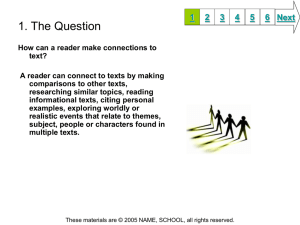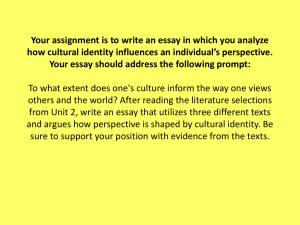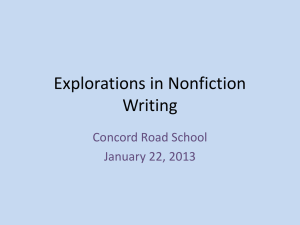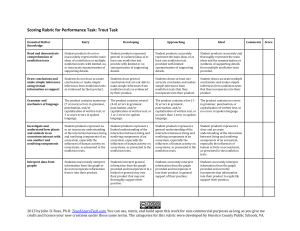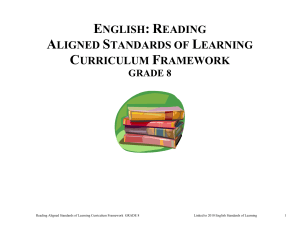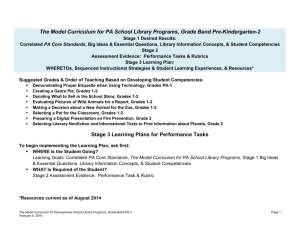8th unit 5 (nonfiction w-grammar) 7-20-2011
advertisement
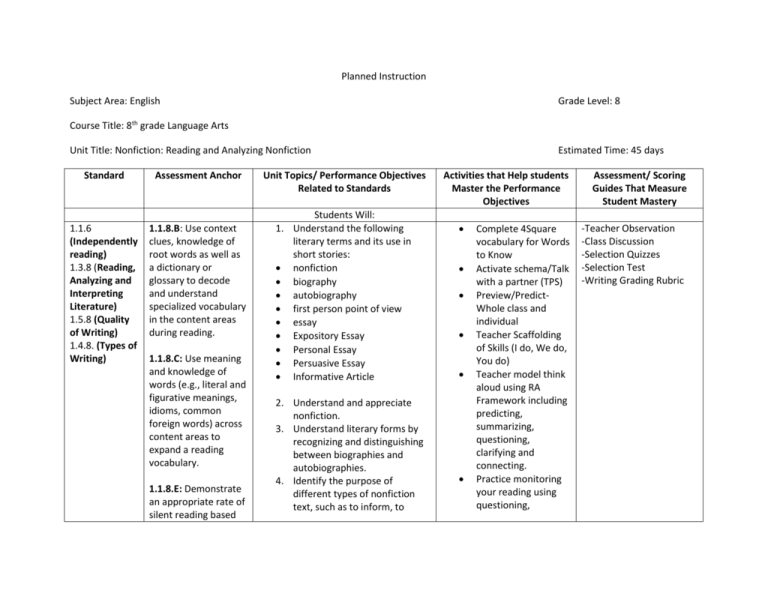
Planned Instruction Subject Area: English Grade Level: 8 Course Title: 8th grade Language Arts Unit Title: Nonfiction: Reading and Analyzing Nonfiction Standard Assessment Anchor 1.1.6 (Independently reading) 1.3.8 (Reading, Analyzing and Interpreting Literature) 1.5.8 (Quality of Writing) 1.4.8. (Types of Writing) 1.1.8.B: Use context clues, knowledge of root words as well as a dictionary or glossary to decode and understand specialized vocabulary in the content areas during reading. 1.1.8.C: Use meaning and knowledge of words (e.g., literal and figurative meanings, idioms, common foreign words) across content areas to expand a reading vocabulary. 1.1.8.E: Demonstrate an appropriate rate of silent reading based Unit Topics/ Performance Objectives Related to Standards Students Will: 1. Understand the following literary terms and its use in short stories: nonfiction biography autobiography first person point of view essay Expository Essay Personal Essay Persuasive Essay Informative Article 2. Understand and appreciate nonfiction. 3. Understand literary forms by recognizing and distinguishing between biographies and autobiographies. 4. Identify the purpose of different types of nonfiction text, such as to inform, to Estimated Time: 45 days Activities that Help students Master the Performance Objectives Complete 4Square vocabulary for Words to Know Activate schema/Talk with a partner (TPS) Preview/PredictWhole class and individual Teacher Scaffolding of Skills (I do, We do, You do) Teacher model think aloud using RA Framework including predicting, summarizing, questioning, clarifying and connecting. Practice monitoring your reading using questioning, Assessment/ Scoring Guides That Measure Student Mastery -Teacher Observation -Class Discussion -Selection Quizzes -Selection Test -Writing Grading Rubric upon grade level texts 1.1.8.D: Demonstrate comprehension / understanding before reading, during reading, and after reading on grade level texts through strategies such as comparing and contrasting texts, describing context, analyzing positions and arguments, and citing evidence in text. 5. 1.2.8.A: Evaluate text organization and content to determine the author’s purpose, point of view. 11. R8.A.1.4.1: Identify and/or explain stated or implied main ideas and relevant supporting details from text. 14. 15. 6. 7. 8. 9. 10. 12. 13. 16. 17. R8.A.2.1.2: Identify and/or apply meaning of content-specific words used in text. influence, to express and to entertain. Develop effective strategies for reading nonfiction. Recognize how the author’s perspective or point of view affects the text. Distinguish face and opinion in various text. Understand and appreciate a memoir. Identify the main idea of a nonfiction selection. Analyze a work of literature, showing how it reflects the heritage, traditions, attitudes, and beliefs of its author. Understand and appreciate an anecdote. Identify author’s purpose and voice. Understand and appreciate a essay. Visualize descriptive language Access time and places in America’s history through fictional writing Understand and appreciate a feature story Understand chronological order visualize, connecting, predicting, clarifying and evaluating. Small and large group discussions about themes, characters, and purposes using the literature for examples and proof of findings. Review story and literary terms using writing and/or others vocabulary study skills. Summarizing with a partner Teacher model Double Entry Journal/Talking to the test pair/shared/whole group QAR Word Wall Google Field Trip R8.A.2.3.1: Make inferences and/or draw conclusions based on information from text. R8.A.2.4.1: Identify and/or explain stated or implied main ideas and relevant supporting details from text. R8.A.1.1.2: Identify and/or apply a synonym or antonym of a word used in text. R8.A.1.3.1: Make inferences and/or draw conclusions based on information from text. R8.A.1.3.2: Cite evidence from text to support generalizations. R8.A.1.4.1: Identify and/or explain stated or implied main ideas and relevant supporting details from text. R8.A.2.5.1: Summarize the major points, processes, and/or events of a nonfictional text as a whole. R8.B.2.1.1: Identify, explain, interpret, describe, and/or analyze examples of personification, simile, metaphor, hyperbole, and imagery in text. R8.B.2.1.2: Identify, explain, interpret, describe, and/or analyze the author’s purpose for and effectiveness at using figurative language in text. 1.2.8.E: Read, understand, and respond to essential content of text and documents in all academic areas. 1.2.8.D: Draw inferences and Writing Objective: Students Will: 1.Use written text as a model 2.Revise a draft to make the order of events clear 3. combine sentences to make compound subjects and predicates 4. To indentify and correctly use adjectives in writing. Prewriting Activities to activate possible responses with graphic organizers Draft responses using outline Revise and edit writing individually or with partners using conclusions based on a variety of information sources, citing evidence from multiple texts to support answers R8.A.2.3.2: Cite evidence from text to support generalizations. 1.1.8.C: Use meaning and knowledge of words (e.g., literal and figurative meanings, idioms, common foreign words) across content areas to expand a reading vocabulary. 1.1.8.E: Demonstrate an appropriate rate of silent reading based upon grade level texts 1.1.8.D: Demonstrate comprehension / understanding before reading, during 5. To indentify and correctly use predicate adjectives in writing. 6. To indentify and correctly use pronouns and nouns as adjectives in writing. 7. To identify and correctly use adverbs in writing. 8. To identify and correctly use comparative and superlative forms of the adjectives and adverbs in writing. 9. To identify and correctly use some commonly confused adjectives and adverbs. 10. To identify and avoid using double negatives in writing. ARC Objective: Practice reading strategies at their independent levels. writing strategies to make events clear Peer Conference Teacher Conference Teacher conferences Logbook worksheets Completion of steps Ongoing throughout the year: •Teacher conferences with students •Book Sharing with Class •Log signed by parents/ guardians/ teacher daily reading, and after reading on grade level texts through strategies such as comparing and contrasting texts, describing context, analyzing positions and arguments, and citing evidence in text.






